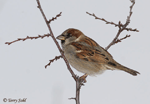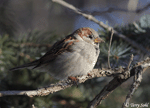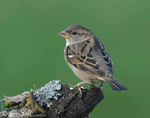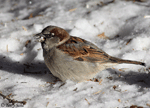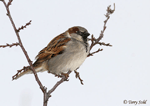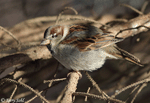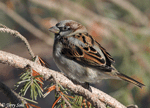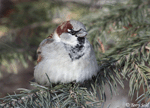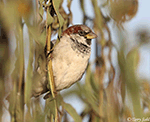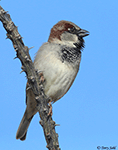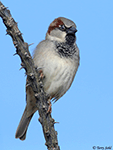| Length: 6 inches | Wingspan: 10 inches | Seasonality: All Seasons |
| ID Keys: Male has black bib, gray crown, chestnut nape. Female gray underparts, black and buff stripes on back | ||
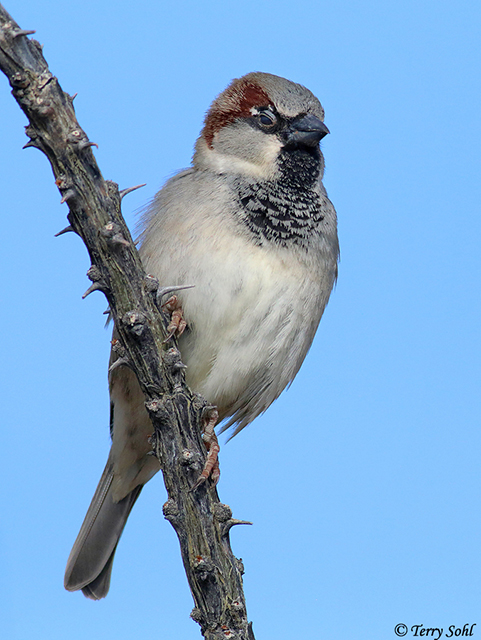 House
Sparrows are one of the most widespread and abundant birds in
the state, and throughout most of North America. The House Sparrow is
native to Europe and Asia. It was first introduced in the 1850's in
New York City and rapidly spread over most of the continent. The House
Sparrow strongly associates with areas of human activity, hence its ability to
adapt to nearly any urban habitat. Unpopular with many because it
out-competes many native songbirds for nesting locations. A male is
pictured on the right.
House
Sparrows are one of the most widespread and abundant birds in
the state, and throughout most of North America. The House Sparrow is
native to Europe and Asia. It was first introduced in the 1850's in
New York City and rapidly spread over most of the continent. The House
Sparrow strongly associates with areas of human activity, hence its ability to
adapt to nearly any urban habitat. Unpopular with many because it
out-competes many native songbirds for nesting locations. A male is
pictured on the right.
Habitat:
Nearly always around man-made structures, from densely populated urban centers to residential areas and farmsteads.
Diet:
Primarily seeds, including those of weeds, grasses, and waste grain. Also eats insects, fruits, and berries. Has adapted to urban settings and will eat crumbs and other food left by humans.
Nesting:
April through July in South Dakota. The nest of a House Sparrow is typically a cavity, now primarily in man-made structures, but also in natural cavities if available. They will readily use nest boxes, often evicting species for which the box was made (e.g., bluebird boxes). Inside the cavity, they fill nearly all the open space with coarse material, lined with finer material. That material may be man-made or natural, including anything from small twigs and grasses, to pieces of string or even plastic. The female lays 3 to 7 eggs, with both parents helping to incubate them. The young hatch after 12-14 days, and fledge from the nest another 10-14 days after hatching.
Song:
The song of a House Sparrow is a very simple, cheerful, and short cheree, often heard with multiple short songs in succession.
- Click here to hear the song of a male House Sparrow1
- Click here to hear the chattering calls of a small group of House Sparrows2
Migration:
Permanent resident throughout its range.
Similar Species:
They are easy to identify compared to most native species. There's only one species that is really close in overall appearance to the House Sparrow:
- Eurasian Tree Sparrow - Another species from Eurasia, the Eurasian Tree Sparrow normally isn't found in South Dakota. They were introduced near St. Louis over 100 years ago, but never relaly spread very far from there. Until 2018, there had never been a confirmed sighting in the state. That spring, one Eurasian Tree Sparrow was seen in a yard in Vermilion, South Dakota. Just a few days later, two Eurasian Tree Sparrows were, in all places...my back yard! I was looking out by the feeders, and saw two "House Sparrows" that didn't look quite right. I grabbed my binoculars, and became extremely excited to see they were indeed Eurasian Tree Sparrows (of which I did manage to get good photos). The two species are similar in overall structure, size and plumage. However, plumage patterns on their head are substantially different. Eurasian Tree Sparrows have a rich brown cap that extends backwards to the nape, and a distinctive black spot in the middle of their cheek. House Sparrow (males) have a chestnut color behind their eyes and extending to their nape, with a gray cheek that lacks any dark mark like the Eurasian Tree Sparrow.
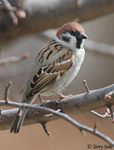 |
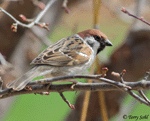 |
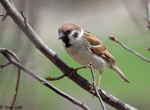 |
| Eurasian Tree Sparrow | Eurasian Tree Sparrow | Eurasian Tree Sparrow |
Interactive eBird Map:
Click here to access an interactive eBird map of House Sparrow sightings
Feeders:
Will attend feeders for most seeds, grains, bread, and fruit.
Nest Boxes:
Will use man-made nest boxes, often taking over nest boxes meant for bluebirds or other species.
Conservation Status:
Despite their reputation as an omnipresent species in US cities and towns, populations of House Sparrows have actually been declining steadily in recent decades. In their native Europe, they have had even stronger declines in recent years. However, they are still one of the most broadly distributed species in the world, and are very common in many parts of their range. The IUCN considers the House Sparrow to be a species of "Least Concern".
Further Information:
Photo Information:
December 27th, 2018 - Saguaro National Park in Arizona - Terry Sohl
Additional Photos:
Click on the image chips or text links below for additional, higher-resolution House Sparrow photos.
Audio File Credits:
- 1Jordi Calvet. Recorded near Barcelona, Spain on April 6th, 2020. Original recording and information from xeno-canto.
- 2Oscar Campbell. Recorded in the United Arab Emirates on March 17th, 2020. Original recording and information from xeno-canto.
| Click on the range map for a higher-resolution view |
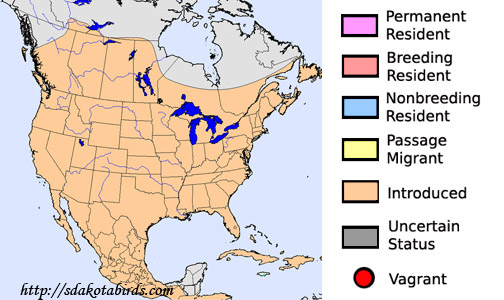 |
| South Dakota Status: Common permanent resident across the state. |
Additional House Sparrow Photos
Click for a higher-resolution version of these photos
